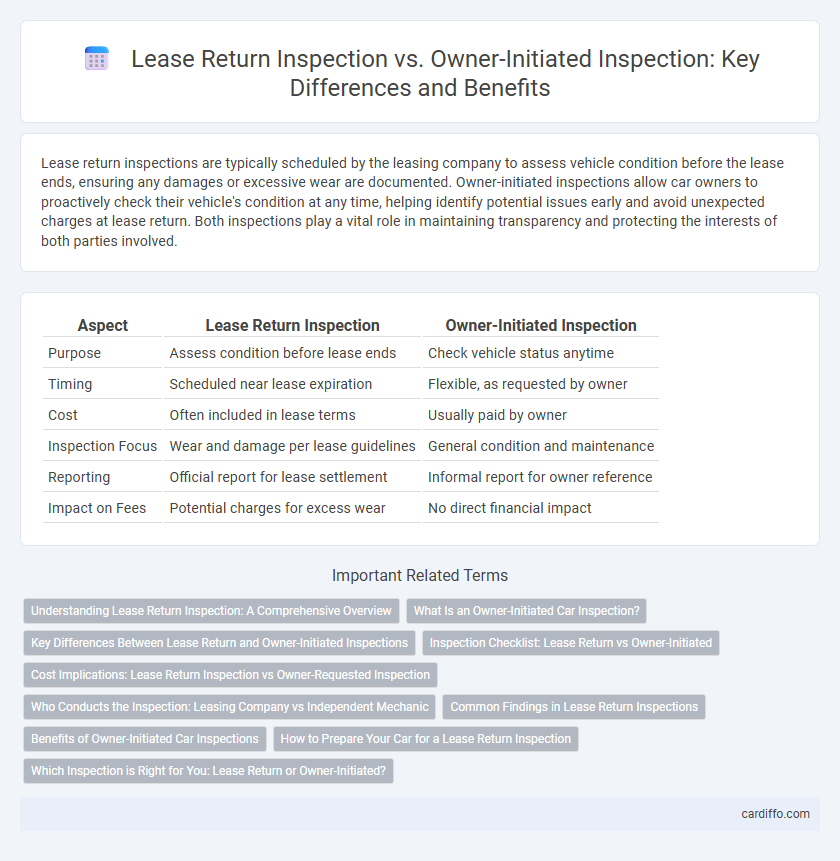Lease return inspections are typically scheduled by the leasing company to assess vehicle condition before the lease ends, ensuring any damages or excessive wear are documented. Owner-initiated inspections allow car owners to proactively check their vehicle's condition at any time, helping identify potential issues early and avoid unexpected charges at lease return. Both inspections play a vital role in maintaining transparency and protecting the interests of both parties involved.
Table of Comparison
| Aspect | Lease Return Inspection | Owner-Initiated Inspection |
|---|---|---|
| Purpose | Assess condition before lease ends | Check vehicle status anytime |
| Timing | Scheduled near lease expiration | Flexible, as requested by owner |
| Cost | Often included in lease terms | Usually paid by owner |
| Inspection Focus | Wear and damage per lease guidelines | General condition and maintenance |
| Reporting | Official report for lease settlement | Informal report for owner reference |
| Impact on Fees | Potential charges for excess wear | No direct financial impact |
Understanding Lease Return Inspection: A Comprehensive Overview
Lease return inspection evaluates a vehicle's condition against lease agreement standards, identifying excessive wear, mileage overages, and potential charges. Owner-initiated inspections, in contrast, allow vehicle owners to assess condition proactively, addressing issues before lease end to avoid fees. Understanding these inspection types helps lessees manage end-of-lease responsibilities and maintain vehicle value effectively.
What Is an Owner-Initiated Car Inspection?
An owner-initiated car inspection is a proactive vehicle evaluation requested by the vehicle owner before lease-end or sale, aimed at identifying potential repairs or issues early. This inspection helps owners avoid unexpected costs by addressing wear and tear or mechanical problems ahead of official lease return inspections. It often provides detailed reports on the car's condition, supporting informed decisions about maintenance or negotiating lease-end terms.
Key Differences Between Lease Return and Owner-Initiated Inspections
Lease return inspections focus on assessing vehicle condition against lease agreement standards, identifying excess wear, mileage overages, and potential fees. Owner-initiated inspections allow vehicle owners to evaluate maintenance needs, detect early damage, or verify repair quality independent of lease terms. Timing and purpose distinguish these inspections, with lease returns occurring at contract end and owner-initiated inspections happening at any point for proactive vehicle care.
Inspection Checklist: Lease Return vs Owner-Initiated
A Lease Return Inspection checklist primarily focuses on wear and tear assessment, mileage verification, and compliance with lease terms to determine potential charges. In contrast, an Owner-Initiated Inspection checklist emphasizes general vehicle condition, maintenance needs, and damage evaluation to ensure timely repairs. Both checklists include detailed interior and exterior inspections but differ in purpose and specific criteria aligned with lease agreements or owner preferences.
Cost Implications: Lease Return Inspection vs Owner-Requested Inspection
Lease return inspections typically incur standardized fees outlined in the lease agreement, often covering wear-and-tear assessments essential for determining end-of-lease charges. Owner-initiated inspections can result in varied costs depending on the service provider and the scope, potentially increasing expenses due to additional assessments or repairs requested. Understanding these cost implications helps lessees and owners budget effectively and avoid unexpected charges during or after the inspection process.
Who Conducts the Inspection: Leasing Company vs Independent Mechanic
Lease return inspections are typically conducted by the leasing company or its authorized agents to assess vehicle condition and determine any excess wear and tear charges. Owner-initiated inspections are usually performed by independent mechanics chosen by the vehicle owner to provide an unbiased assessment prior to lease-end. The leasing company's inspection focuses on contract compliance, while independent mechanics evaluate overall vehicle health without contractual constraints.
Common Findings in Lease Return Inspections
Common findings in lease return inspections typically include excessive tire wear, minor body dents, scratches, and interior stains exceeding normal wear and tear guidelines. These inspections focus on identifying damages that affect the vehicle's residual value or could lead to additional lease-end charges. Owner-initiated inspections often reveal similar issues but allow proactive repairs before lease termination, reducing end-of-lease penalties.
Benefits of Owner-Initiated Car Inspections
Owner-initiated car inspections offer the advantage of early detection of mechanical issues, allowing car owners to address problems before lease return or sale, thereby preserving vehicle value. Regular inspections conducted by owners help maintain accurate records of the car's condition, which supports transparent negotiations and prevents unexpected charges during lease return. This proactive approach enhances vehicle safety, minimizes costly repairs, and ensures compliance with lease terms.
How to Prepare Your Car for a Lease Return Inspection
Preparing your car for a lease return inspection involves thoroughly cleaning the vehicle inside and out and repairing any minor damages such as dents, scratches, or chipped paint to meet the leasing company's standards. Inspect tires for proper tread depth and ensure all fluids are topped off to avoid penalties during the lease-end evaluation. Document the car's condition with photos and service records to provide proof of proper maintenance and avoid unexpected charges.
Which Inspection is Right for You: Lease Return or Owner-Initiated?
Lease return inspections are typically required by leasing companies to assess vehicle condition before contract completion, highlighting wear and tear relative to lease agreements. Owner-initiated inspections provide greater flexibility, allowing vehicle owners to identify potential issues early, potentially avoiding costly repairs or penalties at lease-end. Choosing between lease return and owner-initiated inspections depends on factors like contract terms, vehicle usage, and the owner's goal for maintenance or sale preparation.
Lease return inspection vs owner-initiated inspection Infographic

 cardiffo.com
cardiffo.com